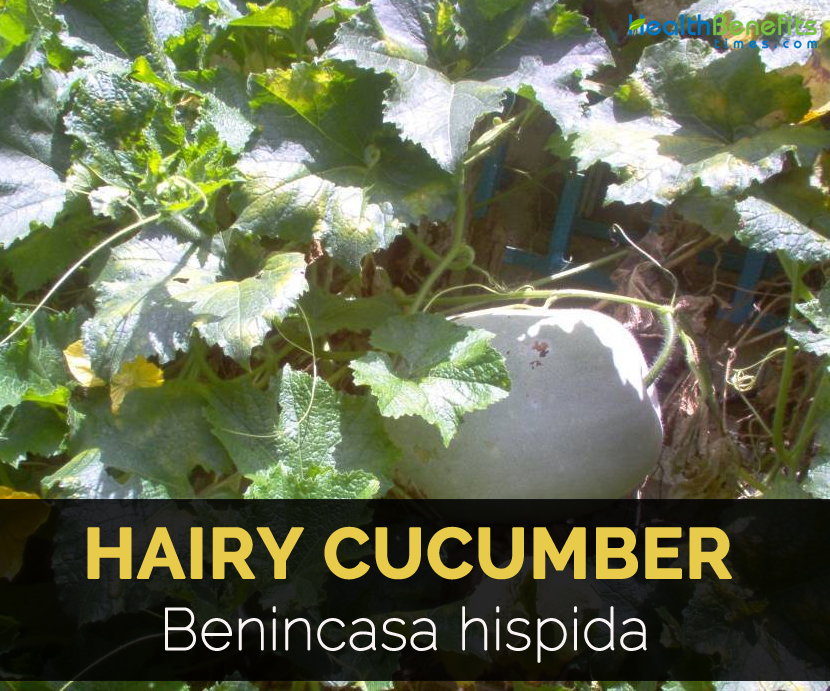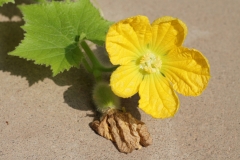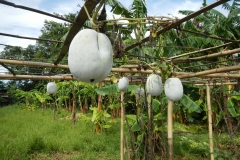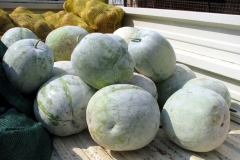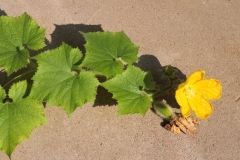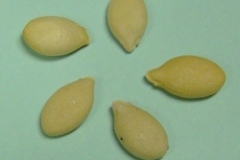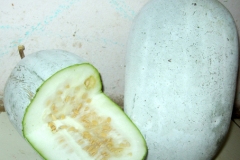The origin of this variety is uncertain but Indo China and China are deemed to be the center of greatest diversity. Since 500 AD, it is cultivated widely in Southeast Asia. Probably, it is endemic to Japan and Java and cultivated more/less throughout warm countries. This popular crop was widely used for nutritional as well as medicinal purposes. It is an important sub-tropical and tropical cucurbitaceous vegetable grown in India, China, Philippines and some parts of Asia.
It prefers rich and well-drained soil with ample moisture in the growing season. It grows well in warm and sunny position and it also tolerates drought. It requires pH in the range 5.8 to 6.8 and also grown best in greenhouse. The plants perform well when they get stable temperature in excess of 25 degree Celsius. The female flower develops with short day length and low temperature and on the other hand, it requires higher temperatures to stimulate male flower production. Seeds become mature in the duration of 5 months to produce a mature crop.
Facts About Hairy Cucumber
| Hairy Cucumber Quick Facts | |
|---|---|
| Name: | Hairy Cucumber |
| Scientific Name: | Benincasa hispida |
| Colors | Green to dark green |
| Shapes | Oblong cylindrical, clavate or dumb-bell-shaped, 15–23 cm long by 5–10 cm across |
| Flesh colors | White |
| Name | Hairy Cucumber |
|---|---|
| Scientific Name | Benincasa hispida |
| Common/English Name | Festival Gourd, Fuzzy Melon, Fuzzy Gourd, Hairy Cucumber, Hairy Melon, Hairy Gourd, Jointed Gourd, Winter melon, Ash gourd, Ash guard, Winter gourd, White pumpkin, Wax gourd, White gourd, Tallow gourd, Gourd melon and Chinese watermelon |
| Name in Other Languages | Chinese: Jie Gua, Chieh Kua (Festival Gourd), Mao Gua, Mao Kua (Hairy Gourd); Japanese: Heariimeron; Malaysia: Mao Kua (Cantonese), Kundor Panjang, Timun Balu (Malay); Thai: Faeng: Vietnamese: Bi; English: Chinese preserving-melon, Chinese-watermelon, Ash gourd, Wax gourd, Waxgourd, White gourd, White-pumpkin, Winter-melon; German: Wachskürbis; French: Courge cireuse longue verte Sanskrit/Indian name: Kushmanda Indonesia: kundur, bligo, kundo; Malaysia: kundor; Philippines: kondol (Tagalog), tibiayon (Bisaya), rodal (Bicol); Cambodia: trâllaach; Laos: tônx; Thailand: fak, faeng, mafaeng; Vietnam: bí dao, bí xanh; Hindi: Pethakaddu (पेठाकद्दू), Petha (पेठा); Kannada: Budekumbalakayi, Boodu Gumbala; Malayalam: Kumbalam, Kumbalanga (കുമ്പളങ്ങ),Elavan; Manipuri: Torobot, Torobot (তোৰোবোত); Marathi: Kohla (कोहळा ); Nepali: Kubindo; Tamil: Neer Poosanikai Telugu: Boodida Gummadikaaya; Denmark: voksagurk |
| Growing Climate | Annual climber |
| Soil | Well-drained |
| Stem | 4-10 inches long |
| Flower | Yellow, large and unisexual |
| Fruit shape & size | Oblong cylindrical, clavate or dumb-bell-shaped, 15–23 cm long by 5–10 cm across |
| Fruit weight | 2-50 kg |
| Fruit color | Green to dark green |
| Flesh color | White, spongy and juicy |
| Flavor/aroma | Mild, subtle |
| Seed | Ovate-elliptical, flattened, 1–1.5 cm long, yellow-brown |
Plant description
Fuzzy gourd is an annual climber with trifid tendrils. Leaf lamina is deeply lobed, dentate and softly hispid on 15-20 cm long. Flowers are bright yellow and 6-12 cm across. Fruit is green to dark green, oblong cylindrical, clavate or dumb bell shaped about 15–23 cm long by 5–10 cm across. Flesh is white. The plant is monocious vine type which bears large green fruits. Fruits have white or yellowish white seeds. The color of the seed changes from white to yellowish brown.
Stem
Stem is much branched, thick, 5-sided, furrowed and covered with sharp bristles. Tendrils (split at 3 cm into 2 to 3) each 15 cm, slender and rarely simple. It sprawl over ground or climb like pumpkin.
Leaves
Leaves are large, roundish, kidney shaped and base is deeply heart shaped. Upper surface is rough and lower surface is shortly bristly with blade 10-25 cm long and as much broad.
Flowers
Flowers are solitary, yellow, flat faced and sexes are separate. Male flowers are 5-15 m long with 3 stamens of 1 cm length. Female flowers are 2-4 cm long and style dividing into three. Petals are spreading, blunt and ending in short point.
Fruit
Fruits are spherical, hairy and fuzzy and ripen dark green with white wax and outer layer is hard. The skin color of immature fruits is light or dark green to purple blue. Flesh is white and fruit is covered with downy hairs.
Seeds
Seeds are flat, numerous, ovate-elliptic, 10-15 mm × 5-7 mm × 1-2 mm and yellow-brown.
Health benefits of Hairy Cucumber
- Antiulcer activity
Study was conducted to determine healing of ulcers induced by indomethacin due to antioxidant activity of fruit extract of Hairy Cucumber on ulcers in rats. There was increase in SOD in RBC and homogenate levels and Vitamin C in plasma. In animals, there was apparent decrease in ulcer index treated with fruit extract. It contains certain active principles such as flavonoid C- glycosides and sterols, terpenes. It inhibits gastric mucosal injury by scavenging free radicals and repress production of SOD and Vitamin C.
- Antidiarrheal activity
Studies suggest that Benincasa hispida fruit extract in graded doses lowered diarrhea by inhibiting intestinal peristalsis, PGE2-induced enteropooling and gastrointestinal motility. BHFE, on preliminary studies claimed it as potential antidiarrheal agent, an underlying mechanism appears to be spasmolytic and anti-enteropooling property by which fruit and its extract provide relief from diarrhea.
- Anticompulsive activity
Methanolic extract of Hairy Cucumber fruit exhibited anti-compulsive effect in mice by inhibiting marble-burying behavior and it was comparable to that of fluoxetine. Its anti-compulsive effect was observed that sub effective dose of MEBH potentiated the effect of sub-effective dose of fluoxetine and exhibited the significant inhibition of marble burying behavior. Phytochemical studies revealed that the presence of tryptophan in extract is an important precursor of serotonin in serotonergic neurons and enhances the biosynthesis of serotonin to facilitate the anticompulsive effect of MEBH.
- Antidepressant activity
Methanol extract of Benincasa hispida fruit has antidepressant activity which was evaluated using modified forced swim test. In forced swim test, MEBH showed significant reduction in immobility.
- Anti-angiogenic activity
Study was conducted to evaluate anti-angiogenic effect of seed extract of Hairy Cucumber. The study showed that seed extract of Hairy Cucumber reduced bFGF-induced endothelial cell proliferation and tube formation in a dose-dependent manner. Results also showed that seed extract inhibit proliferation of endothelial cells persuaded by bFGF which explains anti-angiogenic properties.
- Antioxidant role
Antioxidant has a crucial role in managing neurodegenerative diseases including Alzheimer’s disease. The study conducted with aqueous pulp extract showed that chronic treatment with BH pulp extract increased the number of correct choices in radial Y arm maze. Study showed the antioxidant propertiy of BH extract for managing colchicine induced rat model of Alzheimer’s disease.
- Gastroprotective activity
Study found the gastroprotective effect of methanol extracts and petroleum ether of Hairy Cucumber. These extracts caused significant reduction in ulcer index in rats and results are comparable with omeprazole treated group. The gastroprotective activity lowers reduction in vascular permeability, lipid perioxidation, free radical generation with strengthening of mucosal barrier.
- Renoprotective activity
Renal ischemia induced oxidative stress are related with impaired kidney function which leads to marked increase in serum creatinine, uric acid levels and urea. Hairy Cucumber prevents the kidneys from severe attenuation of antioxidant enzyme activity in rats. It improved the impaired kidney function.
- Nootropic activity
Study was carried out to investigate cognitive function by enhancing effect of methanol extract of Hairy Cucumber fruit. MEBH produced significant reduction in number of entries and increase in percentage of alteration. It can be concluded that MEBH exhibits prominent nootropic effect and antiamnesic effect in both models of memory.
- Hypochlorhydria
Hypochlorhydria is a risk factor of gastric carcinoma, anemia and Helicobacter pylori infection. In the study, hypochorhydria was induced by rantidine, a histamine receptor antagonist. The study evaluated the protective effect of pre-administration. The herbal extracts recovered the gastric secretion and provide satisfactory results in Vitamin C concentration in gastric juice.
Traditional uses
- It is medicinally used to treat various complaints such as respiratory disease, gastrointestinal problems, diabetes mellitus, heart disease and urinary disease.
- Traditionally fruits are used as laxative, tonic, diuretic, cardiotonic, aphrodisiac, blood disease, urinary calculi, epilepsy, insanity, schizophrenia, other psychologic disorders dyspepsia, jaundice, menstrual disorders and fever.
- Fruits are used to cure urinary infection, renal disease and biliousness.
- Apply the ashes of rind to painful wounds.
- Seeds act as anti-inflammatory, anthelmintic, diuretic, demulcent, laxative, febrifuge, expectorant and tonic.
- Use the decoction internally for treating vaginal discharges and coughs.
- Fruit is an aphrodisiac, antiperiodic, tonic, laxative and diuretic.
- It is used for treating epilepsy, asthma, lung diseases and coughs in Ayurvedic medicine.
- Use the fruit juice for treating insanity, nervous diseases and epilepsy.
- Root infusion is used for treating gonorrhea.
- Take it internally for urinary dysfunction and summer fevers.
- Seeds are used in Ayurvedic medicine for fevers, coughs, excessive thirst and expel tapeworms.
- Fruit juice is effective for snakebites and mercury poisoning.
- Use the fruit as a mouth gargle for mouth cancer and to protect teeth and gums or bleeding gums.
- It helps to reduce pitta and heat in the body, lower eye inflammation, redness and strengthen teeth and gums and also treatment for acidity.
- It provides relief from tiredness, itching, lethargy, pains and aches.
- It also lowers burning sensations in soles and palms.
- It stabilizes nerve cells and combats general debility.
- The juice has cooling properties which helps in treating peptic ulcers.
- Seeds promote growth of tissues.
- For anemia and debility, take fruits, grind it and add sugar according to the taste. Take 1 tablespoon twice a day.
- For dandruff and baldness, crush the seeds and boil two tablespoon of powder in one cup coconut oil till it turns red. Strain it and apply on the scalp regularly.
- To eliminate tapeworms, fry one tablespoon seeds in ghee and consume it regularly.
- To treat ulcers, wash the fruits properly, peel them and cut it. Discard seeds. Boil them and squeeze then add equal quantity of water. Add a little salt and drink it twice a day.
- For internal bleeding, take gourds, eliminate skin and cut it into pieces. Boil them with sufficient water, squeeze it and take it with one tablespoon of Indian Gooseberry juice.
Culinary uses
- Fruit is sliced and used in stews, soups, stir-fry on its own or with meat, fish and other vegetables.
- Stuff the gourd with meat, shrimps, and mushrooms and steam it in a pot or fried.
- In Taiwanese recipe, it is shredded and fried with chilies.
- Mature fruits are candied with sugar and can be dried for later use.
- Young shoots, flowers and leaves are consumed as vegetables.
- Fruits are also pickled.
- In Vietnamese cuisine, it is used to make soups and stews.
- In South Indian cuisine, it is used to make curries with a yogurt base.
- In Nepal, it is cooked as vegetable when young.
- Leaves, tendrils and shoots are consumed as greens.
References:
https://www.itis.gov/servlet/SingleRpt/SingleRpt?search_topic=TSN&search_value=505894#null
http://www.missouribotanicalgarden.org/PlantFinder/PlantFinderDetails.aspx?kempercode=e457
http://www.tropical.theferns.info/viewtropical.php?id=Benincasa+hispida
http://tropical.theferns.info/viewtropical.php?id=Benincasa+hispida
https://en.wikipedia.org/wiki/Wax_gourd
https://www.ijariit.com/manuscripts/v5i1/V5I1-1388.pdf
http://herbfinder.himalayawellness.in/benincasa-hispida.htm
https://uses.plantnet-project.org/en/Benincasa_hispida_(PROSEA)
https://indiabiodiversity.org/species/show/244546


